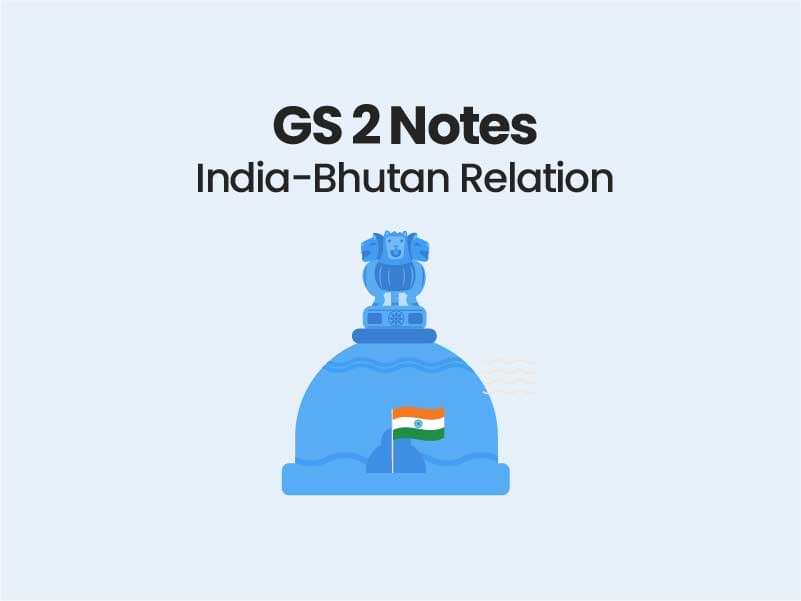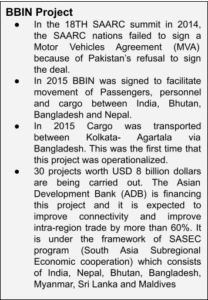Companion@360 → 7 Month programme to sharpen your writing skills → REGISTER NOW

India-Bhutan Relation
Diplomatic relations between India and Bhutan were established in 1968 with the establishment of a special office of India in Thimphu. The basic framework of India Bhutan bilateral relations is the Treaty of Friendship and Cooperation signed in 1949 between the two countries and revised in February 2007. The Golden Jubilee of the establishment of formal diplomatic relations between India and Bhutan was celebrated in the year 2018.
The 1949 treaty amongst others ensured that India will not interfere in the internal affairs of Bhutan and the latter will not import arms and ammunition (Article 2 of the Treaty). Bhutan also had to seek India’s guidance on matters related to its foreign policy.
India and Bhutan share a unique and time tested bilateral relationship, characterized by utmost trust, goodwill and mutual understanding. The special relationship has been sustained by a tradition of regular high level visits and dialogues between the two countries.
- The Manas National Park (Assam) is an ecological asset shared between the two nations.
- Bhutan is a landlocked nation that is sandwiched between India and China. The Himalayan Mountains also forms many features in the country
- In February 2020, Bhutan decided to levy a ‘Sustainable Development Fee’ of USD 17/day on Indian tourists entering Bhutan and staying in the Western districts of the nation. This has raised certain questions on Bhutan’s step to discourage the arrival of Indian tourists.
Areas of Cooperation:
Economic Cooperation and Development Assistance:
- The Government of India has consistently supported the socio-economic development of Bhutan. Hydro-power cooperation between the two countries is an example of win-win cooperation.
- India has been extending economic assistance to Bhutan’s socio-economic development since the early 1960s when Bhutan launched its Five Year Plans. India continues to be the principal development partner of Bhutan. For the 12th Five Year Plan, India’s contribution of Rs. 4500 cr. will constitute 73% of Bhutan’s total external grant component.
- The key areas of focus of GOI’s assistance include agriculture and irrigation development, ICT, health, industrial development, road transport, energy, civil aviation, urban development, human resource development, capacity building, scholarship, education and culture.
- Mutually beneficial hydro-power cooperation with Bhutan forms the core of bilateral economic cooperation. For Bhutan, hydro-power development continues to be a vital catalyst for socio-economic development. The ongoing cooperation between India and Bhutan in the hydro-power sector is covered under the 2006 bilateral agreement for cooperation and its Protocol signed in 2009. Four hydro-electric projects (HEPs) totaling 2136 MW are already operational in Bhutan and are supplying electricity to India. The 720 MW Mangdechhu was commissioned in August 2019. Two HEPs namely, 1200 MW Punatsangchhu-I, 1020 MW Punatsangchhu-II in Inter-Governmental mode and Kholongchhu HEP (600 MWs) under the joint venture mode are under various stages of implementation. In consultation with the Ministry of Power/DoE, the implementation formalities of the 2585 MW Sankosh HEP are currently being finalized.
- India is Bhutan’s largest trading partner. In 2018, total bilateral trade between the two countries stood at Rs. 9227.7 crores. Major exports from India to Bhutan are mineral products, machinery and mechanical appliances, electrical equipment, base metals, vehicles, vegetable products, plastics and articles. The major items of export from Bhutan to India are electricity, ferro-silicon, portland cement, dolomite, carbides of calcium carbides of silicon, cement clinkers, timber and wood products, potatoes, cardamom and fruit products.
- India is the most popular educational destination for Bhutanese students -almost 4000 Bhutanese students are enrolled in Indian Universities at any time, many of whom are also provided scholarships by Govt. of India.
India-Bhutan Relation – Defence and Strategic Relations:
- There is a Secretary-level mechanism on border management and security related matters between the two countries.
- There is also a Border District Coordination Meeting (BDCM) Mechanism between the bordering States and the Royal Government of Bhutan (RGoB) to facilitate coordination on border management and other related matters.
- Both India and Bhutan are founding members of South Asian Association for Regional Cooperation (SAARC) that deals with economic, social and cultural development of South Asian Region.
- Both of them also share other multilateral forums such as BBIN (Bangladesh, Bhutan, India, and Nepal), BIMSTEC (Bay of Bengal Initiative for Multi Sectoral Technical and Economic Cooperation) etc
- ‘Operation All Clear’ conducted in the year 2003-04 by Bhutan to root out insurgent groups from Assam such as United Liberation Front of Assam (ULFA), National Democratic Front of Bodoland (NDFB) and the Kamtapur Liberation Organization (KLO). Over 30 militants’ camps were targeted and more than 650 terrorists were killed.
- The China factor is an important facet of the strategic cooperation between the two countries. In 2017, there was a dispute in the Doklam plateau which is situated in the tri-junction between India (state of Sikkim), Bhutan and China. India warded off Chinese threats and the issue was settled temporarily.
- In 2020, the Sakteng WildLife sanctuary in Bhutan situated close to the Indian state of Arunachal Pradesh was in news. During a meeting of the Global Environment Facility (GEF) (a US based financing body for environmental projects), China objected to the project funding in the Sakteng WildLife sanctuary in the Eastern part of Bhutan. But the objections were overruled.
- These areas which are close to the trijunction of India, Bhutan and China will be a cause for concern for India. India will be closely watching these developments. India is most vulnerable in the Siliguri corridor. This is also called India’s chicken neck. (In the event of a war between India and China, it is a belief that China can seize this corridor and cut off access between India’s mainland and NorthEast regions).
- Bhutan remains the only neighbouring nation of India which neither has diplomatic relations with China nor it is part of its One Belt One Road (OBOR) project.
Cultural Relations :
- A large number of college going Bhutanese students study in India. The Government of India provides a number of scholarships to Bhutanese students.
- Regular cultural exchanges take place between the two countries. One of the basic objectives of India Bhutan Foundation established in 2003 is to enhance people to people exchange in cultural field.
- About 60,000 Indian nationals live in Bhutan, employed mostly in the hydro-electric power construction and road industry.
- In addition, around 8000-10,000 daily workers enter and exit Bhutan everyday in border towns.
Bhutan’s Significance to India
Geographical Significance:
- Bhutan shares a border with four Indian States: Assam, Arunachal Pradesh, West Bengal and Sikkim.
- Nestled in the Himalayas, Bhutan serves as a buffer between India and China.
- Security of Bhutan’s present borders, especially its western border, is very important for India.
Economic Significance:
- Bhutan provides a market for Indian commodities and is a destination for Indian investment.
- Also for India, Bhutan is a rich source of hydropower.
Political Significance:
- A politically stable Bhutan is important to India. An unstable and restive Bhutan can provide a safe haven to anti-India activities and anti-India militant groups. In 2007, the two nations amended the 1949 treaty and amended certain important articles. Article 2 which forbade Bhutan from importing arms and ammunition were amended and presently they can import, provided that these imports are not against India’s interests. It is this recognition of the changing nature of relationship that has ensured the sustenance of friendship and cooperation between the two countries. India should recognize the same with respect to its other neighbour Nepal and embrace these changes in its treaty with Nepal.
Read Full GS Notes





